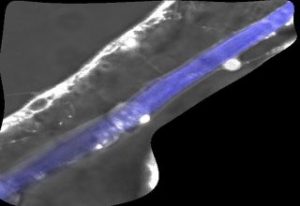When the Sea Urchin Changed Its Genetic Plan
 A new study at the Leon H. Charney School of Marine Sciences has discovered that the sea urchin builds its skeleton in a similar manner to the way mammals and other vertebrates develop their blood vessels. About 550 million years ago, sea urchins – along with other echinoderms – changed the genetic plan that controlled the development of their blood vessels, and turned it into a plan for the construction of a calcium-based skeleton. The study was published in the prestigious journal PNAS. “It’s easier to change an existing genetic plan than to build an entirely new one. The accepted theory is that each phylum of animals developed its own independent way of drawing minerals from the environment to build a skeleton, and there was no single original prototype. We have now found the unique way the sea urchins, and probably all the echinoderms, changes a pre-existing program into a novel, biomineralization program” explains Dr. Smadar Ben-Tabou de-Leon, who led the study.
A new study at the Leon H. Charney School of Marine Sciences has discovered that the sea urchin builds its skeleton in a similar manner to the way mammals and other vertebrates develop their blood vessels. About 550 million years ago, sea urchins – along with other echinoderms – changed the genetic plan that controlled the development of their blood vessels, and turned it into a plan for the construction of a calcium-based skeleton. The study was published in the prestigious journal PNAS. “It’s easier to change an existing genetic plan than to build an entirely new one. The accepted theory is that each phylum of animals developed its own independent way of drawing minerals from the environment to build a skeleton, and there was no single original prototype. We have now found the unique way the sea urchins, and probably all the echinoderms, changes a pre-existing program into a novel, biomineralization program” explains Dr. Smadar Ben-Tabou de-Leon, who led the study.
During the early stages of fetal development, humans and sea urchins are similar in many respects. This is not surprising – many animals are similar during their early developmental stages. The researchers at Dr. Ben-Tabou de Leon’s laboratory are trying to understand how the developmental program is encoded in the genome of the sea urchin and how this program is executed during embryonic development to give rise to the sea urchin embryo. In the present study, the researchers sought to focus on the biomineralization process – the process by which an animal uses the minerals it absorbs from its surroundings and turns them into a skeleton. In the case of sea urchin, the mineral involved in calcium carbonate. According to Dr. Ben-Tabou de-Leon, around 550 million years ago the ability to transform minerals from the environment into a skeleton began to emerge simultaneously among various phyla of animals. Each phylum developed its own unique method, rather than inheriting it from a single joint ancestor. Until now, this theory lacked an exemplifying demonstration.
During the first stage, the researchers noticed that the skeleton that develops in the sea urchin embryos has a tube-like structure. “We saw that the calcite that begins to crystallize is surrounded by a membrane that is in turn surrounded by cytoplasm surrounded by its own membrane. In other words, we have a tube-like structure that is very similar to the structure of our own blood vessels, except that instead of blood the tubes contain calcite,” Dr. Ben-Tabou de-Leon explained.
However, in order to prove that this system is evolutionary related to blood vessels, it was not enough merely to show that the sea urchin deposits a skeleton in a tube-like structure. The researchers also had to show a similarity between the genetic control of the construction of the skeleton tube and the genetic control that builds blood vessels in humans and vertebrates. Indeed, the VEGF (vascular endothelial growth factor) signaling pathway, which is responsible for creating the blood vessels in humans, is also essential for the development of the skeleton in sea urchins. In order to examine the relationship between the sea urchin protein and the human protein, the researchers injected two types of VEGF into the sea urchin embryos: a gene originating from sea urchins and a gene of human origin. They found that both the human and the sea urchin proteins acted in a similar manner to save the process of skeletal development in the embryos where VEGF had been inhibited. They also discovered that some of the genes that VEGF activates during sea urchin development are similar to the genes that control blood vessel formation in vertebrates and humans. “Our findings suggest that sea urchins and the phylum of echinoderms took an earlier genetic plan for creating blood vessels and turned it into a plan for the depositing of minerals and the construction of a skeleton. In evolutionary terms, it seems that it is easier to modify an existing plan than to develop a completely new developmental plan,” Dr. Ben-Tabou de-Leon comments.
What is the significance of this finding? One possible application relates to the fascinating ways in which animals manage to shape minerals into different forms with extreme mechanical strength. The researcher notes that the sea urchin manages to bend calcite crystals and grow them in the desired direction, while maintaining a high level of stiffness in the crystal that is created. If we learn from the sea urchin how to controls crystals in this manner, we will be able to manufacture strong artificial crystals in any shape we desire. She adds that the VEGF pathway plays an important role in progression of cancer, since it controls the growth of new blood vessels into the tumor. These newly generated blood vessels provide oxygen and nutrients to the tumor on one hand and allows it to metastases on the other hand. Accordingly, a better understanding of the complex molecular and cellular mechanisms that VEGF controls may help in the fight against cancer and in the development of new and improved drugs.



